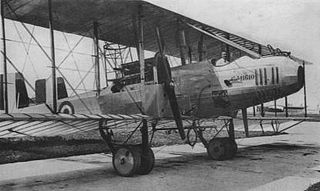
The Caproni Ca.3 is an Italian heavy bomber of World War I and the postwar era. It was the most produced version of the series of aircraft that began with the 1914 Caproni Ca.1 and continued until the more powerful 1917 Caproni Ca.5 variant.

The Caproni Ca.1 was an Italian heavy bomber of the World War I era.

The Caproni Ca.2 was an Italian heavy bomber of the World War I era.

The Caproni Ca.5 was an Italian heavy bomber of World War I and the postwar era. It was the final version of the series of aircraft that began with the Caproni Ca.1 in 1914.

The Caproni Ca.37 was a ground attack aircraft designed and built in Italy by Caproni around 1916.

Between 1911 and 1914, the Royal Aircraft Factory used the F.E.2 designation for three quite different aircraft that shared only a common "Farman" pusher biplane layout.

The Caproni Ca.60 Transaereo, often referred to as the Noviplano (nine-wing) or Capronissimo, was the prototype of a large nine-wing flying boat intended to become a 100-passenger transatlantic airliner. It featured eight engines and three sets of triple wings.

The Boeing GA-1 was an armored triplane. Designed in 1919, it was powered by a pair of modified Liberty engines driving pusher propellers. The first of the Engineering Division's heavily armored GAX series aircraft, the ponderous airplane was intended to strafe ground troops while remaining immune to attack from the ground as well as from other enemy aircraft. It was so well armored that its five-ton weight proved excessive.

The Caproni Ca.135 was an Italian medium bomber designed in Bergamo in Italy by Cesare Pallavicino. It flew for the first time in 1935, and entered service with the Peruvian Air Force in 1937, and with the Regia Aeronautica in January 1938.

The Caproni Ca.101 was a three-engine Italian airliner which later saw military use as a transport and bomber. It was designed in 1927 and first flown in 1928.

The Caproni Ca.73 was an Italian airliner produced during the 1920s which went on to serve as a light bomber in the newly independent Regia Aeronautica.
The Grahame-White Ganymede was a prototype British heavy night bomber intended to serve with the Royal Air Force in the First World War. A large, three-engined, twin-boom biplane, the sole prototype Ganymede did not fly until after the war had ended, and although an attempt was made to convert the aircraft to an airliner, it was unsuccessful.

The Caproni Ca.355 Tuffo was a low-wing single-engine dive bomber, designed and built by the Italian Caproni company in 1941, which never proceeded beyond a single prototype. Derived from Ca.335 Mistral, the Ca.355 was proposed to equip the Regia Aeronautica, but it was found to offer little advantage over the German Junkers Ju 87 "Stuka" and the project was abandoned.
The Caproni Ca.49 was a proposed Italian seaplane airliner of 1919.

The Zeppelin-Staaken Riesenflugzeuge were a series of very large bomber aircraft - Riesenflugzeuge, usually powered by four or more engines, designed and built in Germany from 1915 to 1919.

The Siemens-Schuckert L.I was a large, three-engined biplane bomber aircraft, built in Germany towards the end of World War I. It was a twin boom design, strongly influenced by the successful Caproni Ca.3. Three were built but not used operationally.

The Lloyd 40.08 Luftkreuzer was a three engine triplane bomber type built during World War I. The design was proven to be ineffective and development did not proceed past the prototype stage.
The Caproni Ca.61 was an Italian heavy day bomber aircraft of 1922. It was the final development of the Caproni three engine, twin boom biplane types developed during World War I, but it was not put into production.
The Caproni Ca.66 was an Italian night bomber designed to reequip the post-World War I Italian Air Force. Only two examples of the four-engined biplane were built.
The Caproni Ca.66 and Caproni Ca.67 were Italian night bomber aircraft designed to re-equip the post-World War I Regia Aeronautica.

















